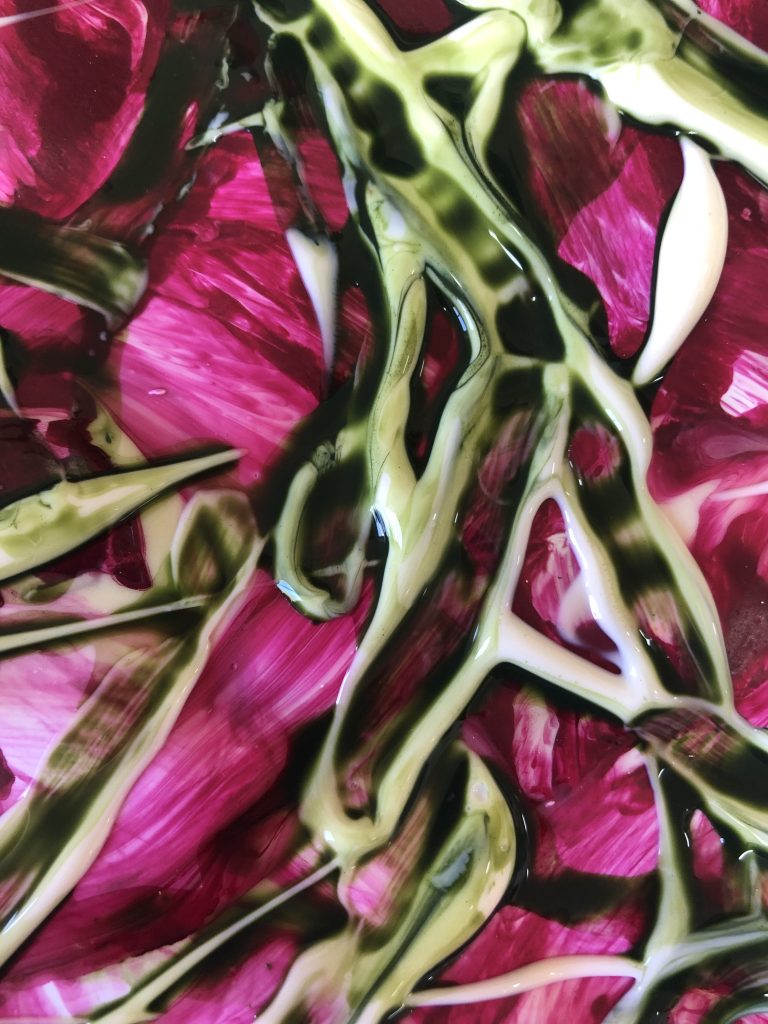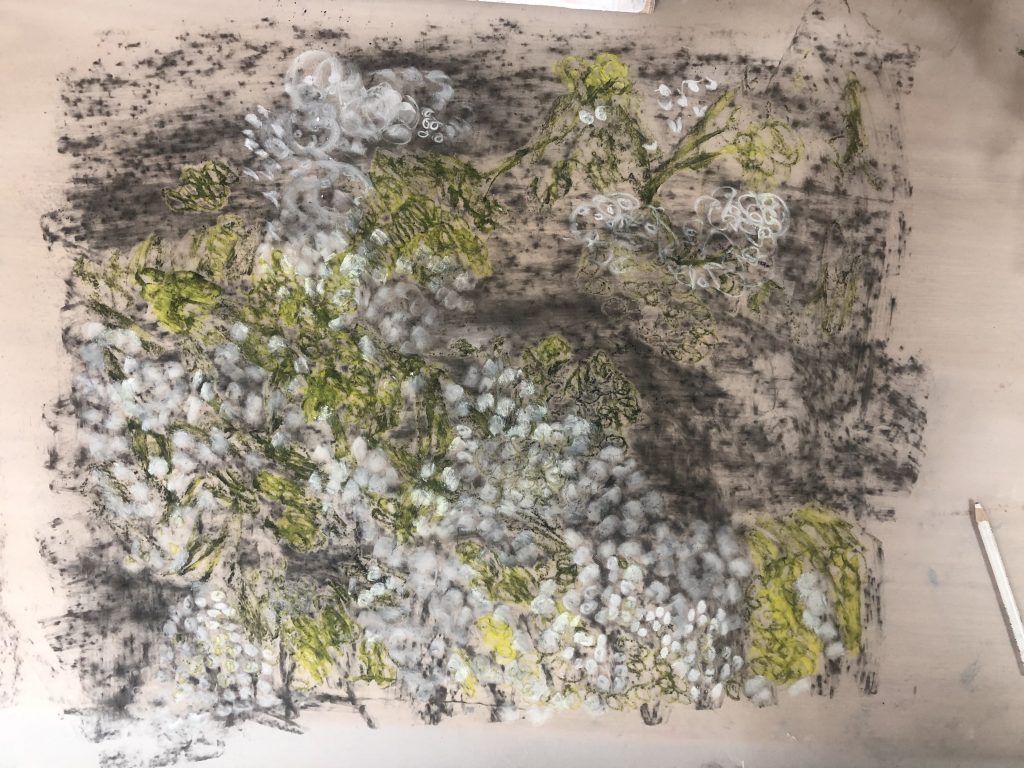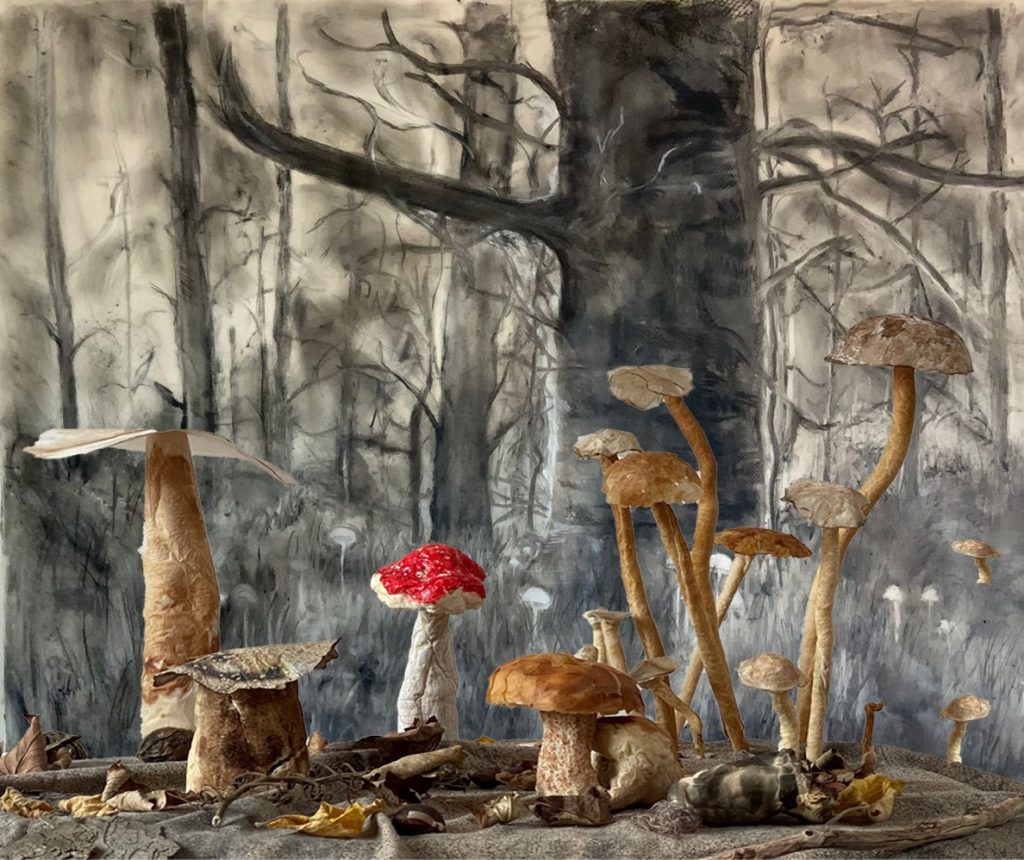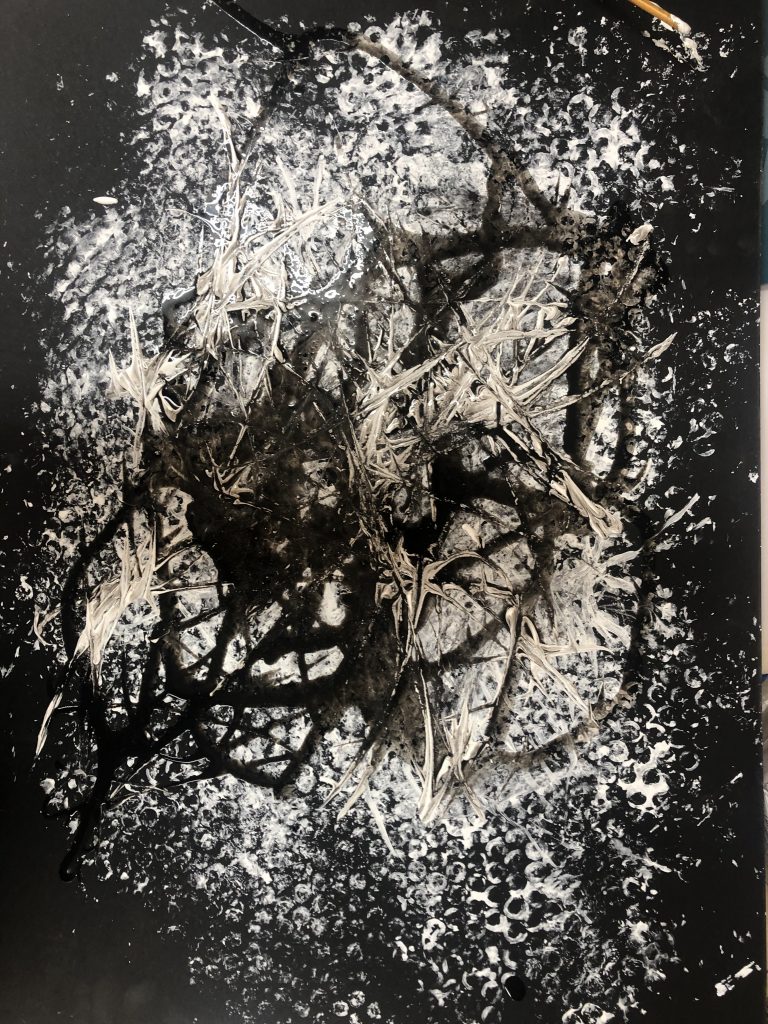THE CRITICAL REVIEW
Introduction
This review looks at materiality and suggests it is a willful agent within my making process.
Setting out to use a practice-led research approach during this course by considering not only paint as a material, led to the exploration of charcoal, ink, and sculpture with clay, foam, wire, paper, cement and fungi. The body of work made alongside the course material was influenced by the subject matter which prompted and provoked me to investigate elements of painting. The physical encounter with material processes unfolded in most unexpected ways as I continued my practice as a mode of inquiry into materials and became more engaged in nature, its entanglements and its role in my own life and creativity.
The Fungal Kingdom became an investigation of making in my Parallel Project. Here I contemplated the idea that the Fungal Kingdom is a form of meshwork, rather than a network, that permeated all landscapes. These thoughts around the idea of a meshwork were influenced by Tim Ingold, when in In Being Alive he writes about entangled lines of life, and describes this as growth and movement, as opposed to simply a network of interacting entities. (2022:63) Studio interactions with materials became an involvement with a living thing as I looked at the mycorrhizal fungi and collaboration possibilities with other artists and the fungi itself. Looking at the idea of Eco Materialism as an emerging art movement became an identifying option, here the idea of multispecies inclusivity, merging ecology and materialism are supported and brings a deeper understanding to look into environmental consequences when selecting materials and taking responsibility for the environmental cost of maintaining my work after it is completed – like considering recyclability or biodegradable options.

Founding my way into the materials as a visual language
Tim Ingold has written on materiality and I do like his reference to Aristotle: ” Long ago, Aristotle argued that if, for example, a sculptor wants to create a sculpture, then they begin with a lump of marble and, in their head, an idea of the form they want to create…………it was Aristotle who argued that in making a thing, you take a formless lump of material and an immaterial form and you put the two together. As the classical Greek word for matter was hyle, and for form was morphe, the idea that in making you combine matter and form came to be known as the hylomorphic model. This notion of making – of imposing form on substance – has been around in the western tradition of thought ever since, and has become in many ways increasingly dominant.”
Ingold opened my mind to the becoming of material – this is a process of development, and by following the material in the way it goes, one is guided by intuition in action. It is what the material does during this making process which became my main interest in materiality in my work. He describes making as follows: “…., making is not about images and objects at all, but about the coupling of awareness, and of movements and gestures, with the forces and flows of materials that bring any work to fruition.” (An Ecology of Materials, pdf read online diaphanes) Research seen from this view is how I would describe the work; it developed as a making process with materials.
This involvement with materials led to an awareness of how materials resisted or became complicit. Petra Lange-Berndt, in How to be Complicit with Materials (2015:18-19)writes about making materials laugh. This reminds me of materiality as a ‘perpetrator’ of gender hierarchies. Work made using my own grey shampoo as a material to paint with, smelled nice and reminded me of femininity. (Part 4, Project 4 Painting without paint in my blog) Barad redefines agency as a matter of intra-action: a neologism signifying what she describes as “the mutual constitution of entangled agencies” (Barad 2007, 33). Being influenced by the work of Cy Twombly and wanting to work with erasure, material as texture led to further exploration of materials that resist the surface. Shoe wax was used as a ground for drawings with charcoal. Wax as a material showed possibilities of having a multiplicity of functions being plastic in its consistency and seen in gendered terms as being linked to femininity and fragility. Georges Didi-Huberman referred to a material fantasy of wax when he writes about the mystic writing pad and the Freudian model of the Wunderblock where ideas of traces, memory and erasure come to the front. (Materiality: Documents of Contemporary Art, 1999:43) New meanings can be given to erasure, like to correct, to obscure, to revise as making and remaking. I learned that erasing can be used to perform or become an act of rebellion. The plasticity of the shoe wax made it possible to draw spontaneously on the vellum paper with the charcoal; to bring in texture and transparency by erasing areas – even though the wax seems sticky and can be seen as a material that resists (it is not porous) – removing it from the surface was an effortless work. I find that as material this resistance as an art material opened up different dialogues with nature in my own making in terms of leaving traces and or memory of making as well as showing some tension which is always hidden in these relationships between humans and nature.
As material wax is not a conventional material that comes to mind when thinking of matter in artistic production; Didi-Huberman concludes wax is ‘downgrading’ not only from a point of view of the material but the academic idea of art in general. (1999:50,51) Fungal bodies are never stable, it always dissolves back into themselves again, reminding us that Nature is a continuous event of decay and remaking. It also became clear that mycorrhizal fungi stay recognizable as fungi even when they partner one can see their fusions and eruptions within plant cells. The Vellum paper used is 100% cotton and wood pulp.
Looking at artists who influenced my making
Artists whom I researched, like Cy Twombly and William Kentridge, have had a strong influence on my explorative methods, such as inscribing, adding, removing, scraping into layers, erasing, repeating and redrawing or reworking. Roland Barthes commented that Twombly “seems to cover up marks as if he wanted to erase them” (1985:179 and 180) I have been considering making as a form of sensemaking or alluding to understanding on my part, and I believe this is why Twombly resonated with my making. I came to see palimpsest as a method in my work, both in writing (thinking about concepts) my blog and art-making. Cy Twombly’s use of paint to cover (erase), and to interrogate with materials as if this is a way to obscure, protect and add more layers to work, became a way into the materials and making.
I was influenced by the work of Radhika Khimji, Lydia Halcrow, and more recently Terry Winters and Sonja Baeumel, as well as local artist, Gwenneth Miller. Most of these artists work across materials as well as painting, drawing and printing and it confronted me with the processes of making and how this inspires new ideas to develop.

Material exploration of the fungi itself
New feminist materialism principles in this dialogue with materials lead to looking at nature, and soon alliances to make were found in the fungal world. These alliances brought on thinking about the nature of things being themselves, and how being entangled makes us not separate or superior to matter. The work being made and still developing did reflect more about this happening or alliances and led to a reflection on my own human experience of these things. A constant reminder of being in awe and the elusive component in everything became part of the reason for expressing – in one of our online tutorials, my tutor talked about ‘what if’ – this rung in my ears for a while when materiality was considered and how drawn I felt to it as the subject to review. When working it became important to share these entanglements between materials and objects, and as if space for more possibilities was opened. Karen Barad talks about ‘intra-action’, to me, it becomes the space of being enmeshed in more than only a human world. In her words, understanding is a process of becoming, not a thing, but a doing. (K Barad, Barad, Meeting the Universe Halfway, p 151)
This insight led to deciding on the title of the collaborative digital work Fig. 4 Involution: fungi, trees and human. The work was developed over time with a collaboration partner who is a textile student and was entered for an online exhibition project led by a student group of OCA in Europe. Wax was used as an underpainting for this charcoal drawing on vellum paper.

Discussions continued within the collaboration around the idea of a strategy for destructing the work. Using fungi to enter it and hopefully consume it, was discussed as a process to follow after the online exhibition opened. A digital image was shared and the 3d made objects made by the other collaborator were placed in front of this image and photographed. This developed into further digital manipulation, which could also be seen as a hybrid between human and machine, to create a final digital work to be shown at an online exhibition opening in June 2022.

On social media, it was discussed if this deconstruction could be seen as performance between the living and our projection of the living (IG post on @karenstanderart, dated 13 June 2022) The deconstruction of the work started in early September 2022 and is still ongoing. I look at the work, which is now outside as an installation with its own aesthetics, it became time based and is currently a living work as mycelium is growing which would hopefully consume the work in the end.
Surface materiality
The work below was made on black cardboard. When doing this work I found my interest moved to the spatial relationships within and between these mycelial meshworks, as well as how they might be perceived from near and far. The play with the surface materiality- how the paint and chalks created textured layers which look as if intertwining, became the motivation to further investigate making as a form of reflection of something which is in many ways imagined. In real life, mycorrhizal fungi are fifty times finer than the finest roots. Bubble plastic was dipped into acrylic paint and formed the underpainting or imprint for drawing and painting.
Using an imprint as an underpainting and considering how fungi as a living material make one question where the body starts and ends. I became interested in these spaces in between – which are not seen by the eye (human) but are entanglements which interconnect with different species underground. Does the dark board reflect on this space which we can not see – a possible juxtaposition of the real and the reflected?

In Monochrome Entanglements above, I visualize a becoming – mycelium growing, but not yet ready to flower and produce mushrooms. I keep in mind that mycelium is not a thing, but a process. (Sheldrake, 2020:7) Sheldrake later describes it as a ‘body without a body plan’ (Sheldrake, 2020:55) The hyphae explore different directions simultaneously, and has no fixed shape. My reference material was the block of mycelium in which I grew oyster mushrooms during this time. How I thought about the materiality has a lot to do with the idea of how mycelium or mycorrhizal fungi collaborate. Merlin Sheldrake writes: “…hyphae travelled into knots and coils. This wasn’t sex……But it was sexy.” (Sheldrake, 2020:140)
Being involved in a living organism, scale becomes an issue, as I could not really work with something which is mostly out of sight – how to experience it, see it or even touch it? I involved myself with something which is in many ways invisible and studied mostly in controlled laboratories. I realise that I see only part of a picture, and I am making it larger in my works, and even considering going much bigger as with the works above. Making spore prints became one way to balance from small to large. I attempted to work with paper and found that the work below, done on aluminium foil, shows the fragility of this living subject as material.
Cultivating fungi reminded me of cultivating a partnership or involvement with the living fungi as a material. It became a framework to consider my own way of looking at the living world: daily posts on social media acted as a form of documentation of interaction, as well as possibilities around awareness and connections with the natural world. I chose the Oyster Mushroom after reading that it is known for its learning to adapt to different environments and act as ‘collaborator’ in environmental cleanup operations. It adapts well to contaminated or disturbed environments.
CONCLUSIVE REMARKS
I explored other media as materials and became influenced by fungi in my Parallel project. My work process was very intuitive as I became more aware of spontaneity and unpredictability as ways I prefer to work in my studio. There is something about process and experience with the thing, the material in this case. Anthropologist Anna Tsing, positions mushrooms as metaphors for companion species, in this I read about collaborations and contamination, always moving forward in our struggle to survive.
Through working with materials, metaphors arose around complexity, resilience, versatility, adaptability, and changeability. Ideas around balance and control were being tested due to the influence of the life force of the fungi. By looking at mycelium I see a creative material production in nature and making became my reaction to find a dialogue or alliance by working with it.
A preference developed to work on thin paper support and explore erasure, and memory by a layering of forms and or colour.
Finding relationships between different works and mediums was a valuable learning curve. This relates to a pushback process of materials during the making, which can be thought of as the effect things have on other things. Bennet writes: “ I equate affect with materiality” (Vibrant Matter, 2010: 2 ) I do feel that as an artist I am treading on some radical materials and building relationships which is less about individuality than it is about a partnership with materials and that this became more integrated into my practice as a metaphor for connectedness between making and materials whilst working.
The materiality of the made art object is something that one can touch, see and interact with and is part of why art will always matter in the literal and figurative sense in my making. I like to think of materiality as how my making became ” traces that are entangled in the web of life” as Lange-Berndt writes when she proposes, “Agency is a matter of intra-acting; it is an enactment, not something that someone or something has. Agency cannot be designated as an attribute of ‘subjects’ or ‘objects'” (ibid.)
Karen Stander
Student: 519407
Langvlei Farm, Riebeek West, South Africa
List of Illustrations
Fig.1 Stander,K . (2021) Mycelium explorations WIP [wet acrylic gels and ink on paper] In possession of: the author: Langvlei, Riebeek West.
Fig. 2 Stander, K. (2022) Colour memories 2 [velour paper, ink,charcoal] In possession of: the author: Langvlei, Riebeek West.
Fig. 3 Stander, K. (2022) Fungi drawing for WWW online exhibition [velour paper, charcoal, wax] In possession of: the author: Langvlei, Riebeek West.
Fig. 4 Holtkamp A and Stander, K (2022) Involution: Fungi, Forest, Human [digital print] In possession of: the authors: Langvlei, Bern and Riebeek West.
Fig. 5 Stander, K. (2022) Monochrome entanglements [black board, acrylic and charcoal] In possession of: the author: Langvlei, Riebeek West.
Bibliography
Barad, Karen (1996) Meeting the Universe Halfway Realism and social constructivism without contradiction [pdf online ] Read pm SCRIBD (Accessed on 04/06/2022)
Barthes, Roland, 1985 Barthes on Cy Twombly [pdf online] Read on SCRIBD 20pages
Bennet, Jane. (2010). Vibrant Matter [downloaded from OCA library and saved as pdf]
Sheldrake, Merlin, 2020 Entangled Life How Fungi Make our Worlds, Change our Minds & Shape our Futures Random House New York Ebook ISBN 9780525510338 [read online as PDF]
Tsing, Ana, 2015 The Mushroom at the End of the World: On the Possibility of Life in Capitalist Ruins (Princeton: Princeton University Press, 2015), 23; 162. [ Read online on SCRIBD]
Weintraub, Linda. What’s Next: Eco Materialism and Contemporary Art. [pdf online] SCRIBD
I
I